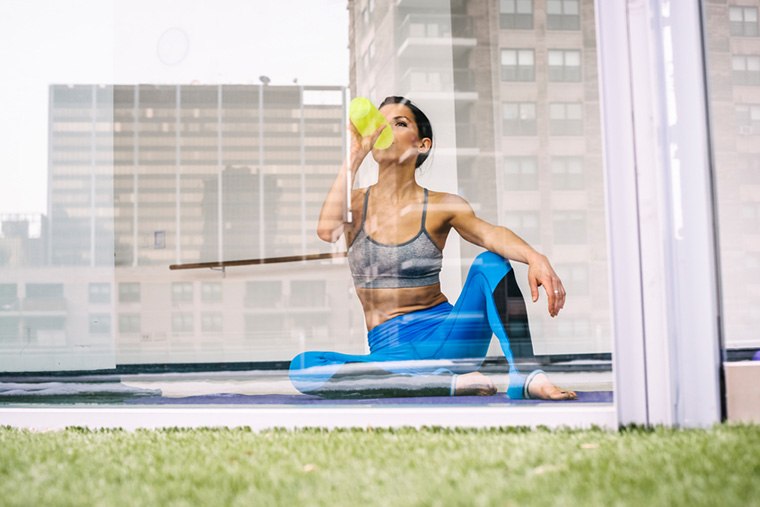Practicing yoga in a heated studio has some serious perks—it'll get your heart pumping, boost your caloric burn, and help you detox all at the same time (similar to taking a hot bath). But is bending your way through an extra-sweaty asana sequence during summer—when staying cool becomes most people's raison d'être—really a good idea?
To figure out if you should modify your practice when temps start creeping into tropical territory, I spoke with cardiologist Nieca Goldberg, MD, medical director of the women’s heart program at NYU Langone’s Joan H. Tisch Center for Women’s Health, and Lauren Porat, founder of YogaSpark, a hot-yoga studio with locations in Mamaroneck, New York and New York City. Turns out, the answer's complicated (kind of like nailing your crow pose) and involves taking multiple factors into account.
Neither could offer an opinion that's as all-encompassing as a universally flattering pair of leggings, but both pros did give some solid advice—which can help you decided whether or not to hit your mat when it’s hot out.
Here's what they say you need to know about hot yoga in the summer before you flow.

The downside of doing hot yoga during summer: "There's more concern because you may be dehydrated," says Dr. Goldberg. Which, TBH, is an issue for everyone when it's hot and humid (either outside or inside a studio)—so monitor your H2O intake and consider increasing your daily goals to counterbalance the water you're losing.

{{post.sponsorText}}
Reason to put your practice on pause: The only people the MD recommends go on a hot-yoga hiatus are those taking medication for high blood pressure or heart disease, because the combination of the heat, drugs, and dehydration is the perfect cocktail for low blood pressure and fainting. (Consult your personal doctor to be sure before you freeze your membership.)
Coolest benefit of continuing your flow: According to Porat, it’s easier to execute moves that require flexibility, like hip openers, because your muscles are already warm when you start working out. That gives you a chance to test out more challenging modifications. "There's less difference between the temperature my body's at when I walk into class and the temperature of the room, [so] I feel like I can achieve a deeper practice,” says the yogi. Just remember what they say about bending 'til you break—be careful not to push past your physical limits.
What to be mindful of before stepping on your mat: The hot-yoga instructor finds most of her clients are the type that can take the heat—no matter how hot it is outside. (Pittas, perhaps?) But she does advise them to take extra precautions during the summer. Aside from drinking plenty of water, she recommends "getting enough electrolytes in your diet, before and after class.” These compounds, like sodium and potassium, help your body balance fluid levels and keep your muscles functioning properly. You lose them when you sweat, making it harder for your system to stay hydrated and regulate heat. To recharge, pack a post-namaste snack, like a banana.
And if you find you can't stand the heat: If you’re feeling overheated or light headed during your practice, listen to your body and talk to your teacher. It may be time to chill out in child's pose or settle into savasana early. Cooling down with a healthy popsicle after class also couldn't hurt.
Summer's the perfect time to take your yoga practice on the road. Here are 7 dreamy spots to add to your bucket list, and the outfits you're going to want to pack.
Loading More Posts...